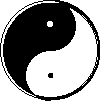13 Rules of Yang Tcc
Author Mike Sigman to neijia list on 2 Mar 1995
These 13 points also appear in chapter VIII of Wile's book
YANG FAMILY SECRET TRANSMISSIONS. A Chapter
suposeddly quoting YCF.
Then who do you think we should attribute these to, YCF or YSC? If you'd
like, I can ask Doug Wile for his source. *If*, as I suspect, these are
from YCF's writings, then the permission from Gin Soon Chu may only make
GSC seem pretentious, when I'm sure that is not the intent of your post.
If you don't mind, I'll add a commentary (shown italic)
of the way I personally would translate the 13 rules. Of course, my
commentary is open to criticism, I just did it not to invite criticism
or to show off, but to share my views (based on experience) and
perhaps provide discussion.
There are thirteen important rules which should merit your attention
and be observed strictly in practising Tai Chi Chuan. They are listed as
follows:
- Set the shoulders down and lower the elbows.
part of setting up an optimal and relaxed peng path
- Hollow the chest and raise the back.
since, for the most part, the peng path is up the back (to about the
lower shoulderblades), then you want to relax the chest and position the
back for transmission optimum.
- Keep the energy leisurely down to the naval psychic-centre (the
capacity 3" below the naval) by hollowing the chest and loosening
the waist. The navel psychic-centre is the place where the energy is
cultivated and reserved. After a long time of Practice, the potential
energy forms a forceful impetus which, when required, can be sent out
to attack and to defend.
As an overly-simplistic example, when you push someone, use the waist
and legs to push along the peng path, the back and arms are just part of
a relaxed transmission path. Don't use any tension or force in the
thorax or arms. In this way the energy comes from the center of the
body, not the arms, shoulders, or thorax.
- Keep the head upright and the body well-balanced.
In order to optimize the use of the peng strength through the body.
- Loosen the waist.
Not only must the ground path (peng strength) come *through* the waist,
the waist should not be tense so that it can add both direction and power
to you internal stength.
- Shift the centre of gravity as required.
Always establish and maintain the best path with which to propagate the
peng path. Of course, this requires body shifts.
- Every part of the body is well co-ordinated.
The body is tied together and works as a unit.
- Do not exert force, but the idea is there.
Don't use muscular force, however be in such a position and will the
existence of the optimum peng path, the path that requires the very least
muscular effort. The peng path is activated by the mind; it is the
concealed strength. Without it, we fall into the situation which YCF
decried, Don't put your dead meathooks on me!
- Action and idea should be in harmony.
`The movement of the body is entirely motivated by the peng jing (which
` the mind must activate). This is *very* important.
- The idea and energy should be in agreement.
Those same movements of the body should be such that the body always
presents and uses postures which optimize the use of the peng jing. In
`other words, the jing drives the body, but it should always drive
the ` body in relation to the best use of jing and target.
- Action is included in inactivity.
The use of the mind to manipulate the peng path (and the very minute
adujustments within the body which accompany this) is the action within
inaction.
- Action and inactivity should be well coupled.
The use of the actual body movement should be coordinated with the
inactive directing of the peng path with the mind(and a bit more...
this is too simplistic)
- All movements should be performed in rhythm and follow one
another evenly without any jerky motion, as silk is drawn from
cocoons.
If the whole body is truly hooked together and driven by peng, it
should not be allowed (nor is it necessary) to make isolated movements
involving local musculature. Allowing and training your motion to always
be connected together is the way the body is used in Taiji.
Mike Sigman
 T'ai
Chi Collection
T'ai
Chi Collection  T'ai
Chi Collection
T'ai
Chi Collection